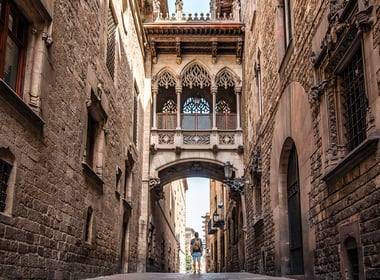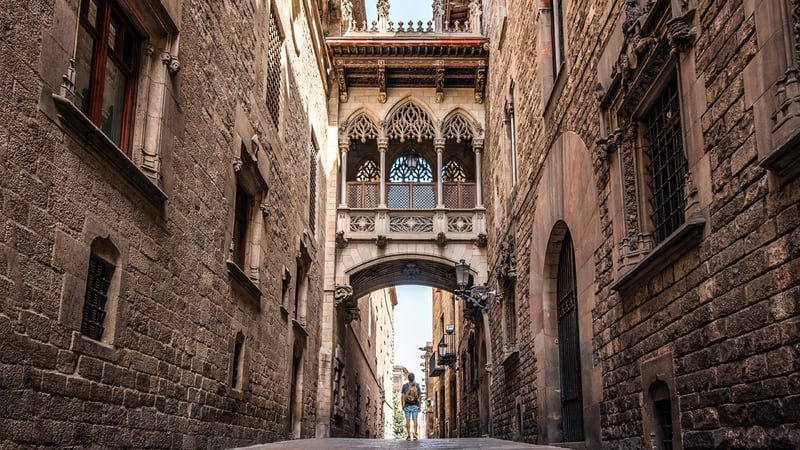İçindekiler
A place in the heart of the city where time seems to stand still: the Gothic Quarter (Barri Gòtic). I stayed in this neighborhood when I first came to Barcelona. This enchanting neighborhood offers a unique blend of past and present while turning through the pages of history. I want to share with you the story of the Gothic Quarter from ancient times to the present, and why this unique place is so special.
Traces of the Roman Empire
The history of the Gothic Quarter dates back to the 15th century BC. The area was initially an Iberian settlement known as Barkeno. However, with the expansion of the Roman Empire in the 1st century BC, it was transformed into an important Roman colony known as Barcino. Walls, roads, and aqueducts from the Roman period can still be seen in the neighborhood today. The Roman wall remains near Plaça del Rei and the columns of the Temple of Augustus are living witnesses to this period. Barcino became a rapidly developing city thanks to its trade and strategic location.

The Middle Ages: The Rise of Gothic Architecture
After the fall of the Roman Empire, the city was ruled by the Visigoths and later by Muslims. However, from the 10th century onwards, with the rise of the Catalan County, Barcelona once again became an important trade center.
During this period, Gothic architecture began to dominate the city, and the Barcelona Cathedral (Catedral de la Santa Creu i Santa Eulàlia) is one of the most magnificent examples of this architectural style. The cathedral, whose construction began in the 13th century, still maintains its splendor today as the product of centuries of work.

The narrow streets, stone houses, and hidden courtyards of the neighborhood carry the atmosphere of the Middle Ages to the present day. Plaça Sant Jaume was the political center of the city during that period and still hosts the Catalan Government and Barcelona City Hall today.
The Renaissance and the Modern Age: Winds of Change
In the 15th and 16th centuries, as Barcelona’s commercial importance declined, the city became more introverted. However, significant developments in art and culture continued during this period. In addition to Gothic architecture, Renaissance and Baroque styles also began to show their influence in the neighborhood. In the 16th century, the city was revitalized with Barcelona’s industrialization. However, during this period, the old neighborhoods fell into disrepair, and some historical buildings began to be demolished as part of modernization movements.

Historic Preservation and Rebirth in the 20th Century
In the 1920s, Catalan architect Josep Puig i Cadafalch and other intellectuals began working to preserve the area, emphasizing the Gothic Quarter’s historical importance. Thanks to this, many historical buildings were restored and the neighborhood was revitalized. During the Spanish Civil War and Franco’s dictatorship, the area once again went through difficult times. However, from the 1970s onwards, with the transition to democracy, the Gothic Quarter became a cultural and tourist center.
The Gothic Quarter Today
Today, the Gothic Quarter is one of Barcelona’s most vibrant and popular areas. With its historical texture, cultural richness, and lively atmosphere, it’s a destination for both locals and tourists.

Places to visit near Gothic Quarter
Barcelona Cathedral: You can visit this magnificent example of Gothic architecture to discover the artworks inside and explore the city view from its terrace.
Plaça Reial: This square, famous for its palm trees and street lamps designed by Gaudi, is filled with restaurants and bars.
Museum of History of Barcelona (MUHBA): An ideal place to explore the city’s history. You can see underground archaeological sites in the museum, which was built over Roman-era remains.
Explore the Streets: By walking through the narrow and winding streets, you can discover small boutiques, art galleries, and traditional tapas bars.
El Call: This area, which hosted the Jewish community in the Middle Ages, might be interesting for history and culture enthusiasts.
The Magic and Importance of the Gothic Quarter
The Gothic Quarter is not just a neighborhood, but the heart and soul of Barcelona. Here, it’s possible to see traces of different eras side by side. You can find a medieval church right next to Roman ruins, and beside that, a modern art gallery. This area is one of the finest examples of how history and modern life can coexist in perfect harmony. While walking through the streets, you might encounter a new surprise at every corner.

While exploring the Gothic Quarter, it’s impossible to notice how time passes. I remember getting lost in the narrow streets during my first visit. You can especially discover the small art market at Plaça del Pi and browse works by local artists. Also, the chocolate and churro shops on Carrer Petritxol and Carrer d’Avinyo are ideal for taking a sweet break.
If you have the chance, I recommend exploring the neighborhood during nighttime hours as well. The lighting of historic buildings and calm atmosphere add a different feel to the area.
Gothic Quarter (Barri Gòtic)
The Gothic Quarter serves as a bridge between Barcelona’s past and present. This unique neighborhood offers unforgettable memories to every visitor with its historical texture, cultural richness, and vibrant atmosphere.
If you really want to get to know Barcelona, make sure to visit the Gothic Quarter.







